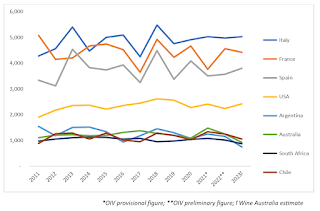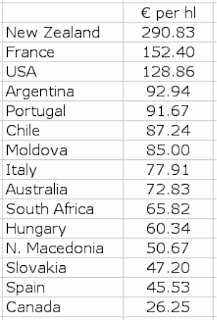Viking is the modern name given to seafaring people originally from Scandinavia (present-day Denmark, Norway and Sweden), who from the late 8th to the late 11th centuries raided, pirated, traded and settled throughout parts of Europe ... The Vikings had a profound impact on the early medieval history of Scandinavia, the British Isles, France, Estonia, and Kievan Rus. *This is all very well, but what did they drink? After all, in Europe this was the Middle Ages or Medieval Period (which lasted approximately from the late 5th to the late 15th centuries). There seem to have been a couple of online articles about this topic recently; and so it is worth discussing.
Actually, this somewhat matters to my own ancestry, given that Morrison is actually a Scandinavian form of name. The ancestor from whom I inherited my surname actually migrated to Australia (where I was born) from Scotland, where there is a Morrison clan (with a tartan, as shown above). However, the Gaelic form of the name should actually be MacMorris, since that is how “son of Morris” is written in the Celtic languages. In Norway, however, the most common form is Morrison, in Denmark it is Morrisen, and in Sweden (where I now live) it is Morrisson.
So, I care what my ancestors drank. As an aside, I will also mention that originally the word “viking” (pronounced “vee-king” in Scandinavia) was a verb, not a noun, describing the raid for which the medieval Norsemen are historically best known. This is a case of the people being known to others for their actions, not their location.
Anyway, the most obvious recent article is in Swedish (Vikingarnas favoritdryck avslöjad), but is about The Vikings’ favorite drink revealed:
You might be thinking mead. When it comes to Vikings and drink, however, it is a completely different drink that dominates. The idea that the raw-barked and relatively primitive Norwegians would sip a glass of cider is perhaps not quite natural in the mouth? ... There is evidence of the production of cider already in the Roman Empire. At the same time, some claim that the Celtic Britons invented the drink, chronologically around the year 50 AD ... What we do know, however, is that the drink was already produced and sold in the 13th century in Norway. It was Cistercian monks from Great Britain who planted apples on the coast of the Hardangerfjord and taught the farmers there how to use the apples — among other things to make cider.
In Norse mythology, the goddess Idunn delivered apples to the gods to preserve their youth and immortality. The Vikings regarded apples as a treasure, and “we know that the Vikings loved to drink alcohol, and it is likely that they made something similar to cider with the apples. But the apples they had were native and not very good, so the Vikings would have used honey to sweeten it. But as soon as you add honey, it becomes mead, not cider, technically speaking,” explains Ellen Marie Naess, archaeologist at Oslo’s Museum of Cultural History. **
The BBC has also had a commentary on the topic: The rebirth of Norway's cider tradition.
I can confirm the modern popularity of home cider-making in Scandinavia, as well as the commercial stuff. My wife and I have made our own, as we have plenty of suitable trees. The apples are pressed at the local commercial press, which is very very busy in season. However, we are just as likely to make juice, which oodles of other people do, as well.
It is also worth noting here that cider is not necessarily dry, in taste. Indeed, Sweden's national liquor chain currently advertises 94 dry Scandinavian ciders versus 83 sweet ones.
As far as actual wine is concerned, any fruits are fair game in Scandinavia. In my own home, we regularly make wine from gooseberries and from cherries, both of which turn out well (ie. we are not embarrassed to give some of the resulting bottles to other people). These usually turn out fairly sweet (ie. not all of the sugar gets fermented), and they are therefore used as dessert wines. The same is true for the grape wines, which we can make from the very large vine on our garage. However, to my way of thinking, the wines never turn out as well as they should — the native grape-vines are, sadly, not a patch on the ones from down south.
As an aside, I will note that California has been known even to mix cider and wine: Sonoma’s co-ferments bring cider and wine together. The idea is that: “A local wine director thinks co-fermenting apples and grapes into pét-nat-style sparklers could help preserve Sonoma’s 150-year-old apple trees.” One can (as in the comment about mead, above) ask: Is this even wine? That is: “By focusing on co-ferments, hybrids and foraged ingredients, a natural wine movement is creating a more expansive and accessible definition of wine.”
Mead, as noted above, is made from honey (and water), to which is added extras ranging from fruits, grains, spices, and apparently even hops. In Viking times it was allegedly favored by the wealthy people, with one resembling the color of blood prized above all (What is Viking "Blod mjød" (Blood mead)?). Given the poor grape-growing climate, mead was clearly much more popular than wine.
In this sense, Medieval wines were being made elsewhere, while the Scandinavians were making cider and mead, and conducting raids. Some people have looked at this topic (Medieval and Renaissance wines: Taste, dietary theory, and how to choose the “right” wine [14th-16th centuries]), and come to the conclusion that: “Reconstructing the taste of wine made at the end of the Middle Ages and in the Reanaissance is a practically impossible task.” However, we do have some ideas about the topic (What was the best wine in the Middle Ages?). Sadly, these ideas “led the wine drinker to consider a dizzying variety of factors in making his choice.” So, you will not find it an easy topic, to either discuss or replicate.
* The Vikings also got to north-eastern North America (via Iceland and Greenland) 500 years before Columbus got to the Caribbean.
** Defining “wine” is not easy (Is the definition of wine changing? The push for ‘low-alcohol’ wines suggests so). In the E.U., for example, it currently must contain at least 8.5% alcohol by volume to be legally labeled as “wine”.















